Inflation risk still high despite price index fall
China still faces a high risk of inflation despite the negative growth of its consumer price index (CPI) and producer price index (PPI) in consecutive months.
The latest figures released by the National Bureau of Statistics show China's CPI and PPI in May declined 1.4 percent and 7.2 percent respectively year on year, an indication that the country's economy is still on the downtrend.
However, international financial signs presage a new round of vicious inflation although the global economy has not yet hit bottom. This is because many developed economies have implemented a quantitative easing policy, and supplies in global base currencies continue growing. The Federal Reserve and the central banks in Britain, Japan, Canada and Switzerland have all taken or said they would take non-traditional measures to spur economic recovery. Even the European Central Bank, which was hitherto cautious on the quantitative easing tool, said such a controversial monetary policy is on the agenda for buying 60-billion-euro worth mortgage bonds. All this shows that some of the world's developed economies have entered the quantitative easing monetary era.
Also, the LIBOR between the dollar, pound and euro, which is usually a common rate of reference for different currencies, has experienced a drastic decline in recent months. This is in contrast to the warming up of prices of some bulk commodities. Still, the big boost on international oil prices has pushed crude oil futures in the New York market to rise by 29.7 percent in May alone - a record monthly hike since March 1999.
The Reuters/Jefferies-CRB Index - designed to provide timely and accurate representation of a long-only, broadly diversified investment in commodities through a transparent and disciplined calculation methodology - has also gained nearly 15 percentage points in the last three months. Also, continuous weakness of the dollar has dampened the prospect of world economic recovery. Worse, the deficit-fuelled growth model applied by the White House has cast a dark shadow over the global economic outlook.
Statistics show the US total budget this fiscal year neared $4 trillion, with a deficit of $1.841 trillion, or 12.9 percent of its gross domestic product. However, it is estimated by the Congressional Budget Office that net government debt will increase to 65 percent in 2010 from last year's 41 percent. This means the world's largest economy would get stuck in the "low growth and high debt" development pattern.

In the context of economic slump, high inflation is likely to become an important option for the US to keep the scale of its national debt within an acceptable level.
History indicates it is not difficult for a nation to raise its inflation level if it is hugely indebted. When it comes to China, the current price situations have become similarly complicated.
The country's May CPI and PPI data continue to remain negative, and this is likely to be so in the coming months. However, China's current downward price momentum bears the typical character of imported deflation, which means the trend can be easily reversed in future.
China has long been forced into passively accepting global price fluctuations. Currently, it is the world's largest iron ore, copper, natural rubber and soybean importer and the world's second largest crude oil importer. Yet China has played a trivial role in determining the price of these commodities.
Last year, China's added oil demands accounted for 41 percent of the increased world demands, but it only held a 0.1 percent of power in deciding world oil prices. Crowned as the global processing and manufacturing center, China, however, has long remained marginalized in the making of the world's trade and resources prices.
Besides, the excess liquidity in China's domestic market is also expected to fuel a new inflation. The continuous inflow of liquidity from abroad will also contribute to the increased monetary supply.
In China, CPI and PPI cannot accurately reflect its price trend. Currently, the World Bank and the IMF mainly use the GDP deflator - a measurement of the level of prices of all new, domestically produced goods and services - to gauge inflation levels of world countries.
According to such a measurement, the US inflation rate in the first quarter was 2.8 percent, while China's was negative 2.5 percent, but showing an upward trend. Such an inflation trend, along with the recent price hikes in some bulk commodities and futures, indicates that imported inflation is approaching China.
Under the circumstances, China's central bank should cultivate sharper insights into international and home financial situations and appropriately adjust its monetary policy. Given that the effects of the M1 and M2 supply on CPI will come in eight to 12 months, the central bank should moderately tighten the country's liquidity, reduce the scale of credit expansion, and stabilize interest rates and deposit reserve rates to avoid the possible risks produced by a major monetary adjustment.
The author is an economics researcher with the State Information Center
(China Daily 06/17/2009 page8)








